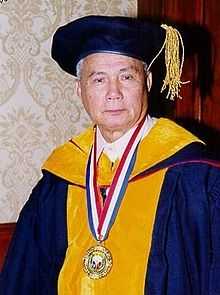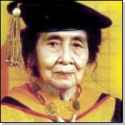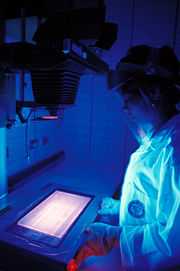Science and technology in the Philippines
| Republic of the Philippines |
|---|
 |
|
|
Science and technology in the Philippines had experienced periods of intense growth as well as long periods of stagnation. The main managing agency responsible for science and technology is the Department of Science and Technology. Numerous national scientists have contributed in different fields of science including Fe del Mundo in the field of Pediatrics, Eduardo Quisumbing in the field of Plant taxonomy, Gavino Trono in the field of tropical marine Phycology, Maria Orosa in the field of Food technology and many more.[1]
History
Pre-Spanish Era
Even before the colonization by the Spaniards in the Philippine islands, the natives of the archipelago already had practices linked to science and technology. Filipinos were already aware of the medicinal and therapeutic properties of plants and the methods of extracting medicine from herbs. They already had an alphabet, number system, a weighing and measuring system and a calendar. Filipinos were already engaged in farming, shipbuilding, mining and weaving. The Banaue Rice Terraces are among the sophisticated products of engineering by pre-Spanish era Filipinos.[2]
Spanish Colonial Era
The colonization of the Philippines contributed to growth of science and technology in the archipelago. The Spanish introduced formal education and founded scientific institution. During the early years of Spanish rule in the Philippines. Parish schools were established where religion, reading, writing, arithmetic and music was taught. Sanitation and more advanced methods of agriculture was taught to the natives. Later the Spanish established colleges and universities in the archipelago including the oldest existing university in Asia, the University of Santo Tomas.[2]
The study of medicine in the Philippines was given priority in the Spanish era, especially in the later years. The Spanish also contributed to the field of engineering in the islands by constructing government buildings, churches, roads, bridges and forts.[2] Biology is given focus. Contributors to science in the archipelago during the 19th century were botanists, Fr. Ignacio Mercado., Dr. Trinidad Pardo de Tavera and Dr. Leon Ma Guerrero, chemist Anaclento del Rosario, and medicine scholars Dr. Manuel Guerrero, Dr, Jose Montes and Dr. Elrodario Mercado.[3]
The Galleon Trade have accounted in the Philippine colonial economy. Trade was given more focus by the Spaniard colonial authorities due to the prospects of big profits. Agriculture and industrial development on the other hand were relatively neglected.[3] The opening of the Suez Canal saw the influx of European visitors to the Spanish colony and some Filipinos were able to study in Europe who were probably influenced by the rapid development of scientific ideals brought by the Age of Enlightenment.[3]
American period

The progress of science and technology in the Philippines continued under American rule of the islands. On July 1, 1901 The Philippine Commission established the Bureau of Government Laboratories which was placed under the Department of Interior. The Bureau replaced the Laboratorio Municipal, which was established under the Spanish colonial era. The Bureau dealt with the study of tropical diseases and laboratory projects. On October 26, 1905, the Bureau of Government Laboratories was replaced by the Bureau of Science and on December 8, 1933, the National Research Council of the Philippines was established.[2] The Bureau of Science became the primary research center of the Philippines until World War II.[4]
Science during the American period was inclined towards agriculture, food processing, forestry, medicine and pharmacy. Not much focus was given on the development of industrial technology due to free trade policy with the United States which nurtured an economy geared towards agriculture and trade.[4]
In 1946 the Bureau of Science was replaced by the Institute of Science. In a report by the US Economic Survey to the Philippines in 1950, there is a lack of basic information which were necessities to the country's industries, lack of support of experimental work and minimal budget for scientific research and low salaries of scientists employed by the government. In 1958, during the regime of President Carlos P. Garcia, the Philippine Congress passed the Science Act of 1958 which established the National Science Development Board.[4]
Post Commonwealth-Era
During the 1970s, which was under the time of Ferdinand Marcos' presidency, the importance given to science grew. Under the 1973 Philippine Constitution, Article XV, Section 1, the government's role in supporting scientific research and invention was acknowledged. In 1974, a science development program was included in the government's Four-Year Development Plan which covers the years 1974-1978. Funding for science was also increased.[4] The National Science Development Board was replaced by the National Science and Technology Authority under Executive Order No. 784. A Scientific Career in the civil service was introiduced in 1983.
In 1986, during Corazon Aquino's presidency, the National Science and Technology Authority was replaced by the Department of Science and Technology, giving science and technology a representation in the cabinet. Under the Medium Term Philippine Development Plan for the years 1987-1992, science and technology's role in economic recovery and sustained economic growth was highlighted. During Corazon Aquino's State of the Nation Address in 1990, she said that science and technology development shall be one of the top three priorities of the government towards an economic recovery.[4]
In August 8, 1988, Corazon Aquino created the Presidential Task Force for Science and Technology which came up with the first Science and Technology Master Plan or STMP. The goal of STMP was for the Philippines to achieve newly industrialized country status by the year 2000.[4] The Congress did not put much priority in handling bills related to science and technology. The Senate Committee on Science and Technology was one of the committees that handles the least amount of bills for deliberation.[4]
Former Science and Technology secretary, Ceferin Follosco, reported that the budget allocation for science and technology was increased to 1.054 billion pesos in 1989 from the previous year's 464 million pesos. However, due to the Asian financial crisis, budget allocation for the years 1990 and 1991 were trimmed down to 920 and 854 million pesos respectively. Budget allocation were increased to 1.7 billion pesoes in 1992.[4]
Fields of Science
Life Sciences
Several Filipino acientist have pioneered in the field of biology. Eduardo Quisumbing, a biologist who graduated MS in Botany at the University of the Philippines Los Baños in 1921, and Ph. D. in Plant Taxonomy, Systematics and Morphology at the University of Chicago in 1923. He conducted research on taxonomic and morphological papers deal with orchids[5] and authored the book Medicinal Plants of the Philippines.[6] The species of Saccolabium quisumbingii was named after him. Dioscoro L. Umali, is an agriculturist that was dubbed as the Father of Philippine Plant Breeding due to the programs he conducted that are related to rainfed and upland agriculture, social forestry, and environmental preservation.[7] Marine biologist helped improve the knowledge on aquatic resources like Angel Alcala, a biologist who was recognized for his research on amphibians and reptiles diversity and marine biodiversity in the country and served as consultant on marine and aquatic projects under the United Nations Environment Programme, World Bank, Asian Development Bank and others,[8] Gavino Trono, a biologist who was dubbed as the Father of Kappaphycus farming for his contributions to the study of tropical marine phycology, focusing on seaweed biodiversity, established the largest phycological herbarium in the country – the G.T. Velasquez Herbarium in the University of the Philippines’ Marine Science Institute, and authored a book that was considered as the most authoritative books in the country on the seaweed flora titled Field guide and atlas of the seaweed resources of the Philippines.[9]
Engineering
Gregorio Y. Zara, a Filipino engineer and physicist that graduated BS in Mechanical Engineering at Massachusetts Institute of Technology (MIT), USA in 1926, and Master of Science in Engineering (Aeronautical Engineering) at the University of Michigan, USA. He had many contributions including a two-way television telephone or videophone (1955) patented as a "photo phone signal separator network", a propeller-cutting machine (1952), the design of Marex X-10 robot and the discovery of the physical law of electrical kinetic resistance called the Zara effect (around 1930).[10]
Social Sciences

Notable Filipino scientist have been contributors in the field of social science in the country. Raul V. Fabella was an academic, economist and scientist that graduated in Seminario Mayor-Recoletos (Bachelor of Philosophy; 1970); the University of the Philippines School of Economics (Master of Arts; 1975); and Yale University (Doctor of Philosophy; 1982). He had written articles in both theoretical and applied fields: political economy and rent-seeking; the theory of teams; regulation; international economics; and mathematical economics and was associated with the concepts of "Olson ratio" in rent-seeking, egalitarian Nash bargainng solutions, and debt-adjusted real effective exchange rate.[11][12] Teodoro Agoncillo, a 20th-century Filipino historian, and received the national scientist awardfor his contributions in the field of history. He graduated from the University of the Philippines (Bachelor of Philosophy; 1934) and finished his Master of Arts degree in the same university in 1935. He also wrote books regarding the Philippine History like History of the Filipino People.[13] Encarnacion Alzona, a pioneering Filipino historian, educator and suffragist became the first filipina to obtain a Doctor of Philosophy. She got her degree in history and a master's degree from the University of the Philippines and later obtained another master's degree in history from Radcliffe College in 1920, and a Ph.D. from Columbia University in 1923. She was an advocate of women suffrage in the Philippines and authored the book The Filipino Woman: Her Social, Economic and Political Status (1565-1933).[14] that stated a stable account for women despite their lack in political and social rights.[15]
Institutions
Research Organiztions
- Philippine Association of Institutions for Research
- International Rice Research Institute
- Irrigated Rice Research Consortium
- CPU Research Center
- Philippine Rice Research Institute
- Philippine Carabao Center
- National Institute of Molecular Biology and Biotechnology
Cultural
See also
References
Citations
- ↑ "Briefer on the Order of National Scientists". Retrieved October 6, 2014.
- ↑ 2.0 2.1 2.2 2.3 Reyes, Francisco (1972). "Historical Background of Science and Technology in the Philippines". Science & Technology in Philippine Society. Manila: UST Publication.
- ↑ 3.0 3.1 3.2 Rodriguez, Socorro M. (1996). "The Early Years of Philippine Science and Technology". Philippine science and technology : economic, political and social events shaping their development. Quezon City: Giraffe Books. pp. 9–10. ISBN 9718967281.
- ↑ 4.0 4.1 4.2 4.3 4.4 4.5 4.6 4.7 Cariño, Virginia S. (1993). "Science and Technology in the Philippines - Past to Present". Philippine science and technology : time for bold moves. Diliman, Quezon City: UP Center for Integrative and Development Studies in cooperation with the University of the Philippines Press. ISBN 9718797084.
- ↑ "Eduardo Quisumbing 1895 -1986". Retrieved October 7, 2014.
- ↑ Quisumbing, Eduardo A. (1978). Medicinal Plants of the Philippines. Katha Publishing Company. Retrieved October 7, 2014.
- ↑ "Dioscoro L. Umali". Retrieved October 7, 2014.
- ↑ "Gomez, Edgardo D.". National Academy of Science and Technology, Philippines. Archived from the original on August 27, 2014. Retrieved August 25, 2014.
- ↑ Gavino, Trono (1997). Field guide and atlas of the seaweed resources of the Philippines. Bookmark. ISBN 9715692524. Retrieved October 7, 2014.
- ↑ "Videophone Inventor: Gregorio Y. Zara". January 28, 2010. Retrieved October 7, 2014.
- ↑ Santos, Tina G. (July 28, 2011). "Academician and economist Raul Fabella is National Scientist". Philippine Daily Inquirer. Retrieved October 6, 2014.
- ↑ "Raul V. Fabella". Retrieved October 6, 2014.
- ↑ Agoncillo, Teodoro (1975). History of the Filipino People. Garotech Publishing. ISBN 9718711066.
- ↑ Alzona, Encarnacion (1932). The Filipino Woman: Her Social, Economic and Political Status (1565-1933). University of the Philippines Press. OCLC 3164551.
- ↑ Alzona, Encarnacion; Camagay, Maria Luisa T. (1996). Encarnacion Alzona: An Anthology. Office of Research Coordination, University of the Philippines. ISBN 9718729070.
Bibliography
- Cariño, Virginia S. (1993). Philippine science and technology: time for bold moves. UP Center for Integrative and Development Studies in cooperation with the University of the Philippines Press.
- Librero, Aida R. (1990). Technology assessment for agriculture in the Philippines. Philippine Council for Agriculture, Forestry and Natural Resources Research and Development, Dept. of Science and Technology.
- Ogena, Ester B.; Brawner, Filma G. (2005). Science Education in the Philippines: Challenges for Development. Science Education Institute, National Academy of Science and Technology, Center for Integrative Development Studies, University of the Philippines. ISBN 9718600205.
- Science, technology, and everyday culture in the Philippines. Institute of Philippine Culture, Ateneo de Manila University. 2003.
External links
- Advanced Science and Technology Institute website
- Department of Science and Technology Philippines website
- National Academy of Science and Technology website
- Philippine Social Science Council website
| ||||||||||||||
| ||||||||||||||
| ||||||||||||||||||||||||||
| |||||||||||||||||||||||||||||||||||||||||||||
